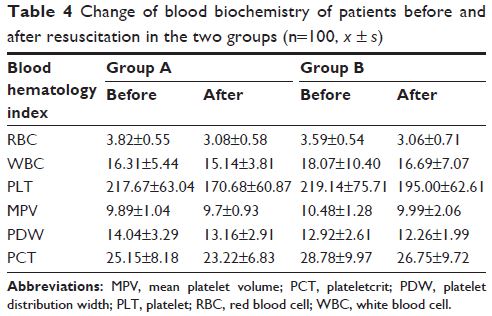9 7 3 1 6
论文已发表
注册即可获取德孚的最新动态
IF 收录期刊
- 3.3 Breast Cancer (Dove Med Press)
- 3.4 Clin Epidemiol
- 2.5 Cancer Manag Res
- 2.9 Infect Drug Resist
- 3.5 Clin Interv Aging
- 4.7 Drug Des Dev Ther
- 2.7 Int J Chronic Obstr
- 6.6 Int J Nanomed
- 2.5 Int J Women's Health
- 2.5 Neuropsych Dis Treat
- 2.7 OncoTargets Ther
- 2.0 Patient Prefer Adher
- 2.3 Ther Clin Risk Manag
- 2.5 J Pain Res
- 2.8 Diabet Metab Synd Ob
- 2.8 Psychol Res Behav Ma
- 3.0 Nat Sci Sleep
- 1.8 Pharmgenomics Pers Med
- 2.7 Risk Manag Healthc Policy
- 4.2 J Inflamm Res
- 2.1 Int J Gen Med
- 4.2 J Hepatocell Carcinoma
- 3.7 J Asthma Allergy
- 1.9 Clin Cosmet Investig Dermatol
- 2.7 J Multidiscip Healthc

小容量复苏对紧急非控制性失血性休克的临床疗效的评价
Authors Zhao G, Wu W, Feng QM, Sun J
Received 22 January 2017
Accepted for publication 23 February 2017
Published 27 March 2017 Volume 2017:13 Pages 387—392
DOI https://doi.org/10.2147/TCRM.S132950
Checked for plagiarism Yes
Review by Single-blind
Peer reviewers approved by Dr Hoa Le
Peer reviewer comments 2
Editor who approved publication: Professor Deyun Wang
Objective: The objective of the present study was to explore the resuscitative
effect of small-volume resuscitation on uncontrolled hemorrhagic shock in
emergency.
Methods: In this study, the resuscitative effects in 200 trauma
patients with uncontrolled hemorrhagic shock in emergency were studied. Half of
these patients were infused with hypertonic/hyperoncotic fluid (small-volume
resuscitation group, n=100), whereas the rest were infused with Hespan and
lactated Ringer’s solution (conventional fluid resuscitation group, n=100). The
changes in hemodynamics, coagulation function, blood biochemistry, blood
hematology, and the average infusion volume in both the groups were
comparatively studied.
Results: It was found that the hemodynamics were improved in
both the groups after resuscitation. Interestingly, compared with trauma
patients infused with Hespan and lactated Ringer’s solution, the growth rate,
range, and time duration of the mean arterial pressure of the patients in
small-volume resuscitation group increased significantly, and the shock index
decreased progressively; in the 60th min after the resuscitation, blood index
including hemoglobin, hematocrit, red blood cells, white blood cells, and
platelet declined, whereas prothrombin time and activated partial
thromboplastin time were prolonged in both the groups, but these changes were
less obvious in the small-volume group. In addition, the average infusion
volume of patients in the small-volume group was less than that of patients in
conventional fluid resuscitation group.
Conclusion: Featured with small infusion volume and less influence
to coagulation function and homeostasis of human body, small-volume
resuscitation possesses a significantly higher resuscitative effect. Therefore,
trauma patients may have a better chance to maintain the hemodynamic stability
and the survival rate, or recovery speed will be increased when traditional
aggressive fluid resuscitation is replaced by small-volume resuscitation.
Keywords: small-volume
resuscitation, shock, hemorrhage, emergency
